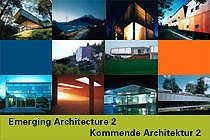
|
Emerging Architecture 2 - Kommende Architektur 2 10 More Austrians Location: Architekturzentrum Wien - Old hall Exhibition: 06 December 2001 - 15 April 2002 Opening Hours: Daily 10:00 am - 7:00 pm Opening: Wednesday 5 December 2001, 7pm Hans Gangoly Volksgartenstrasse 18 A - 8020 Graz AUSTRIA phone +43-316-71 75 50 Fax +43-316-71 75 50-6 office@gangoly.at www.gangoly.at Hans Gangoly on "nextroom - architektur im netz" (in german) born in Oberwart, Burgenland, in 1959. Studied architecture at the TU Graz; diploma in 1988. Founded his own office in Graz in 1994. Board Member, Central Union of Austrian Architects – Styrian Chapter, 1996–99. Lectureship from 1997–99 at the Institute for Building Sciences and Design, TU Graz (G. Domenig). Member of the Board of Diploma Examiners at the Graz College of Technology since 1997. Buildings (select): 1996 Oberwart Fire Department, Burgenland 1998 Hornegg Estate, revitalization, Preding, Styria 1998 G. House, Graz 1998 Hametner Gallery, Stoob, Burgenland 1999 Old City Mill, revitalization (Clients Prize 2000; Prize of Recognition – Piranesi Award 2000) 2000 A. House; all in Graz Under construction: Dreierschützengasse Secondary School "Herzogshof", revitalization; all in Graz Planned: Hausmannstätten Community Center, Graz GAT Formulation Chemistry, Ebenfurth, Lower Austria Border-Crossing Institute of Dialectology, Oberschützen, Burgenland Planning Without Drawing Hans Gangoly does not draw. More precisely, he applies graphic representations merely to communicate with clients, authorities and executive companies. He needs no drawing to design. He develops a structural concept exclusively in his mind and with written notes. Ideally, this concept provides answers to all questions of content and form, as well as economic and technical issues. Says Gangoly, "It is like amathematical equation with many unknowns. If the equation balances at zero, then the design is all right. Such a concept already contains the urbanistic approach and the detail, without a single line being committed to paper." Scripts and depots are constituents of such a concept. Scripts deal with locations and clients, they summarize the issues raised by occupants, their programs and the local circumstances. They motivate project-specific solutions and can most simply be developed when the occupants are concrete persons or when target groups of occupants can be clearly defined. [...] |
 |
|
|
|
Current Preview Permanent Exhibition Emerging Architecture 2 - Kommende Architektur 2 Press Release 10 More Austrians * cukrowicz.nachbaur * fasch&fuchs. * Flöckner Schnöll Architects * Hans Gangoly * gerner°gerner plus * Erich Gutmorgeth * HOLODECK.at * MARTERERMOOSMANN * Gerhard Mitterberger * Wolfgang Tschapeller E-Shop Products: Book: Emerging Architecture 2 / Kommende Architektur 2 DVD: Emerging Architecture 2 - Kommende Architektur 2 Information: Ines Purtauf Tel.: +43 (1) 522 31 15 - 25 Fax: +43 (1) 522 31 17 Email: purtauf@azw.at |
| © Architekturzentrum Wien 2025 |
||



